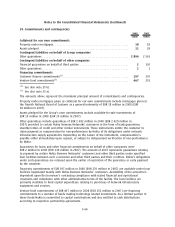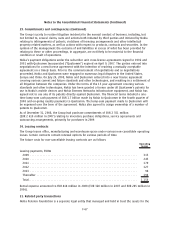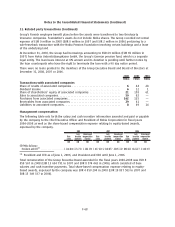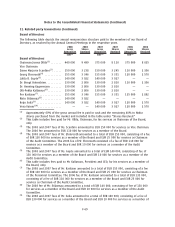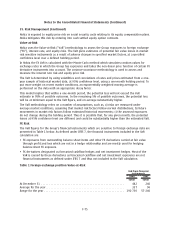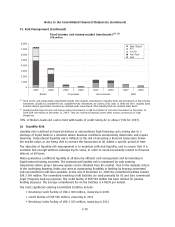Nokia 2008 Annual Report Download - page 220
Download and view the complete annual report
Please find page 220 of the 2008 Nokia annual report below. You can navigate through the pages in the report by either clicking on the pages listed below, or by using the keyword search tool below to find specific information within the annual report.
35. Risk Management (Continued)
Interest rate risk
The VaR for the Group interest rate exposure in the investment and debt portfolios is presented in
Table 2 below. Sensitivities to credit spreads are not reflected in the below numbers.
Table 2 Fixed income investment and debt portfolios ValueatRisk
2008 2007
EURm EURm
At December 31 .......................................................... 6 8
Average for the year ...................................................... 10 12
Range for the year........................................................ 425 527
Equity price risk
The VaR for the Group equity investment in publicly traded companies is insignificant.
(b) Credit Risk
Credit risk refers to the risk that a counterparty will default on its contractual obligations resulting in
financial loss to the Group. Credit risk arises from bank and cash, fixed income and moneymarket
investments, derivative financial instruments, loans receivable as well as credit exposures to
customers, including outstanding receivables, financial guarantees and committed transactions. Credit
risk is managed separately for business related and financialcredit exposures.
Except as detailed in the following table, the maximum exposure to credit risk is limited to the book
value of the financial assets as included in Group’s balance sheet:
2008 2007
EURm EURm
Financial guarantees given on behalf of customers and other third parties ........... 2 130
Loan commitments given but not used ....................................... 197 270
199 400
Business Related Credit Risk
The Company aims to ensure highest possible quality in accounts receivable and loans due from
customers and other third parties. The Group Credit Policy, approved by the Group Executive Board,
lays out the framework for the management of the business related credit risks in all Nokia group
companies.
Credit exposure is measured as the total of accounts receivable and loans outstanding due from
customers and other third parties, plus committed credits.
The Group Credit Policy provides that credit decisions are based on credit evaluation of third parties
including credit rating for our customers. The Group Rating Policy defines the rating principles.
Ratings are approved by the Group Rating Committee. Credit risks are approved and monitored
according to the credit policy of each business segment. These policies are based on the Group Credit
Policy. Concentrations of customer or country risks are monitored at the Nokia Group level. When
appropriate, assumed credit risks are mitigated with the use of approved instruments, such as
collateral or insurance and sale of selected receivables.
The Group has provided impairment allowances as needed including on accounts receivable and loans
due from customers and other third parties not past due, based on the analysis of debtors’ credit
quality and credit history. The Group establishes an allowance for impairment that represents an
F76
Notes to the Consolidated Financial Statements (Continued)


